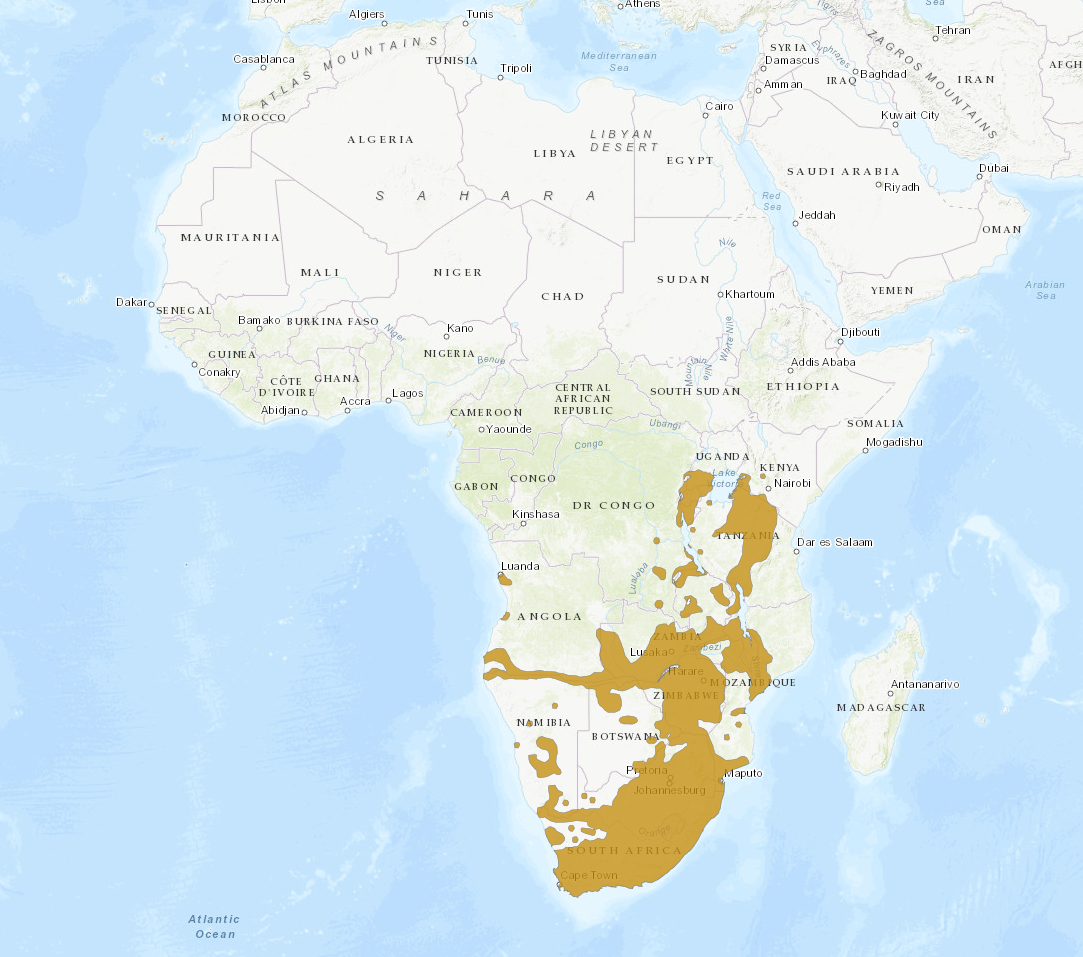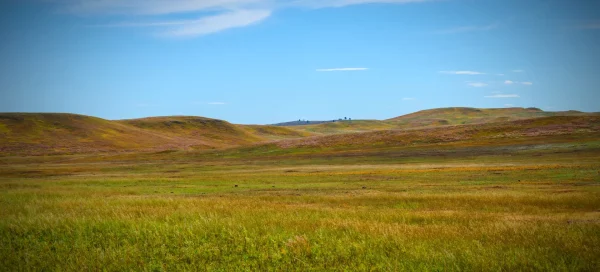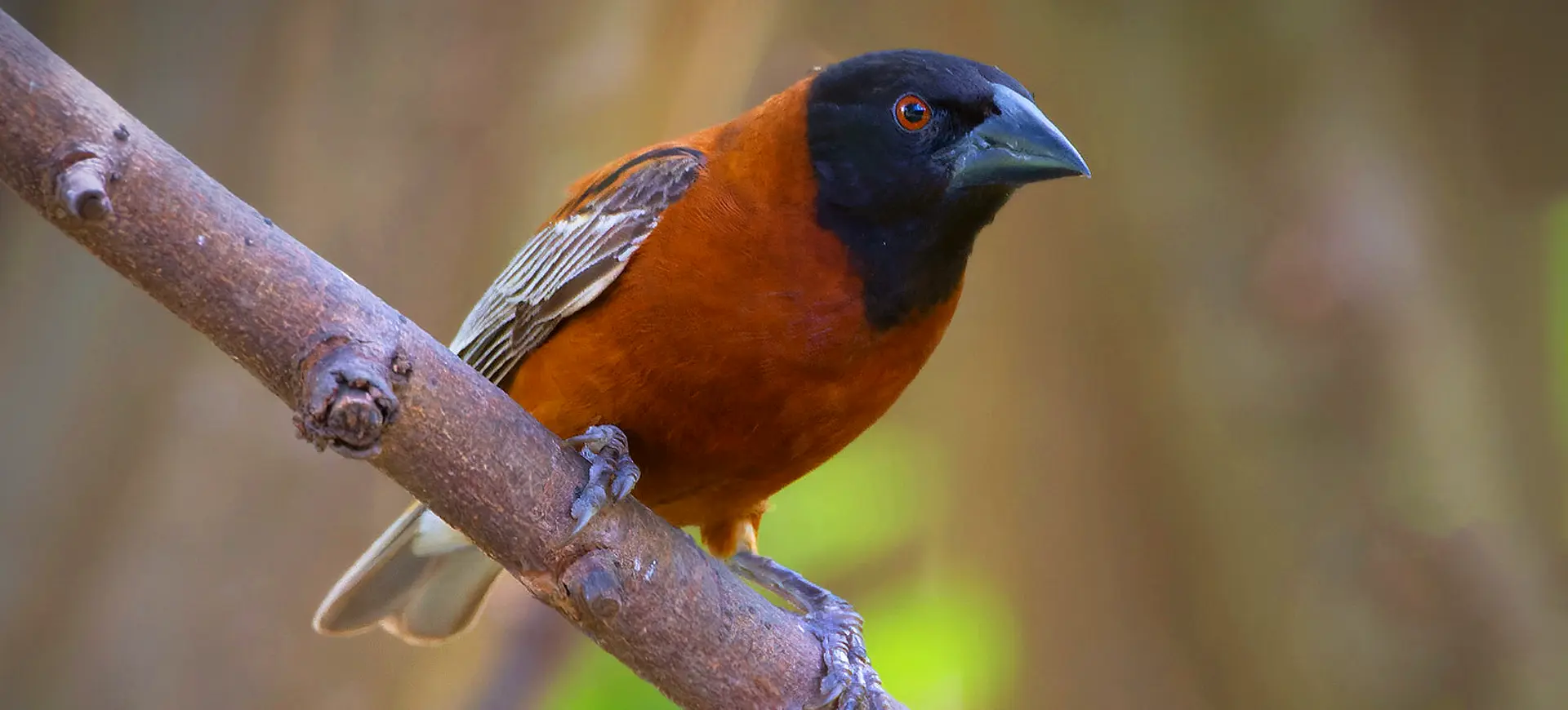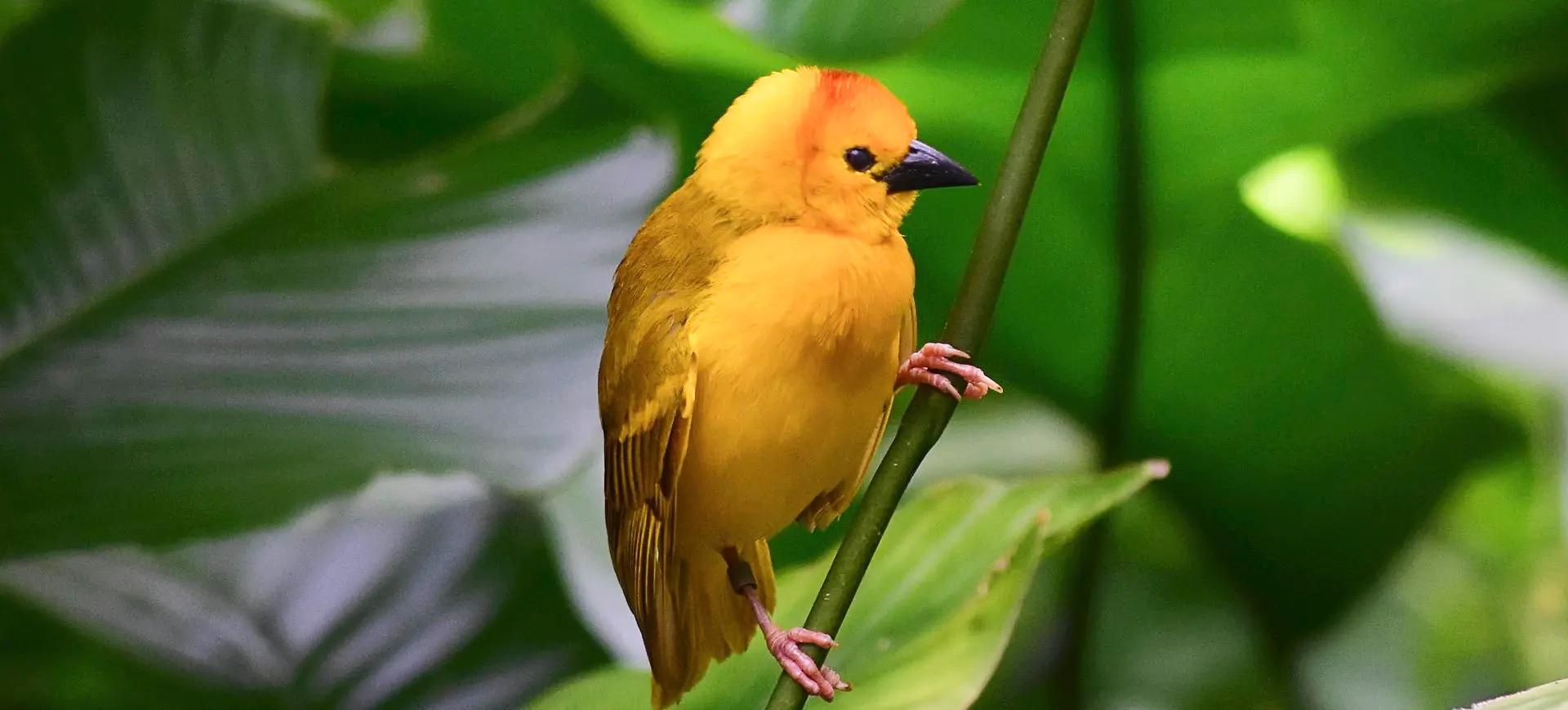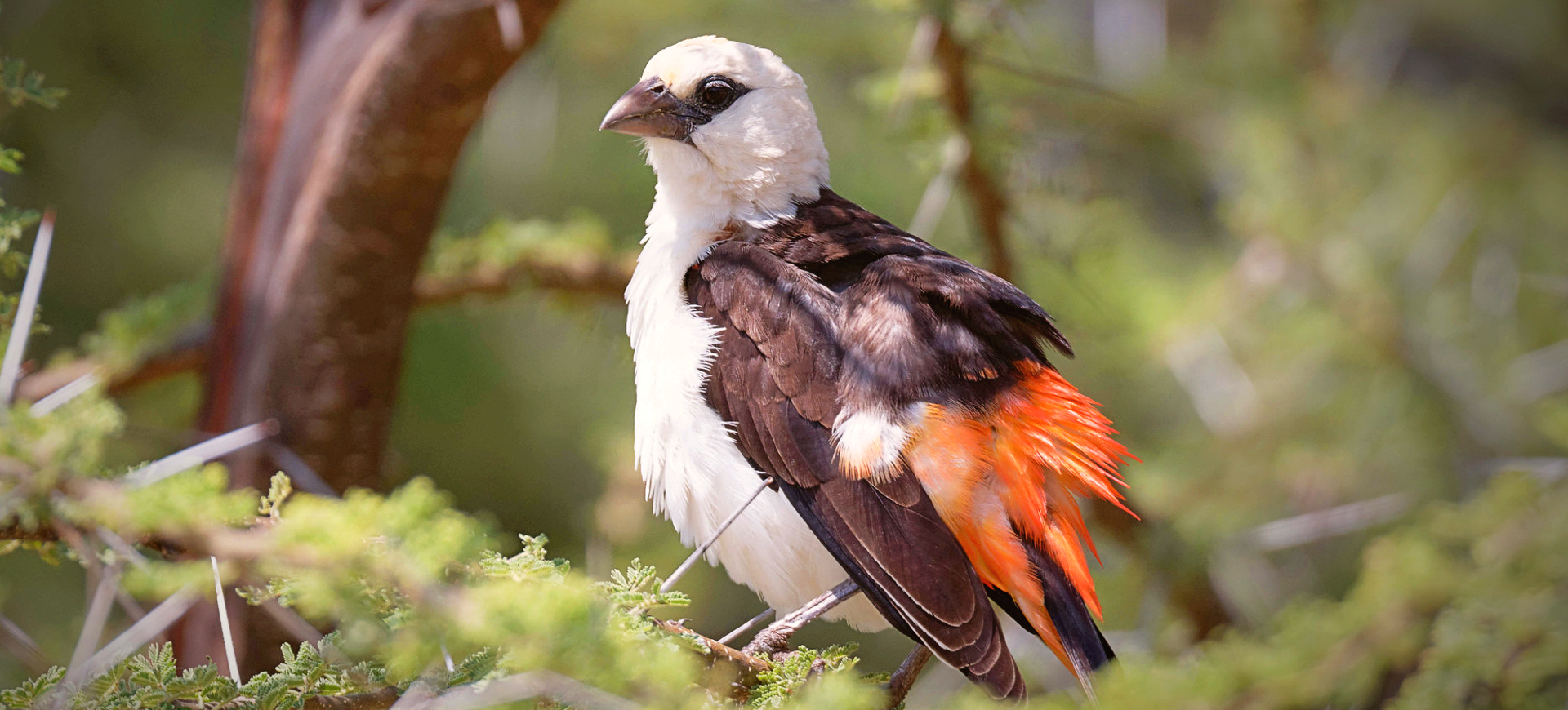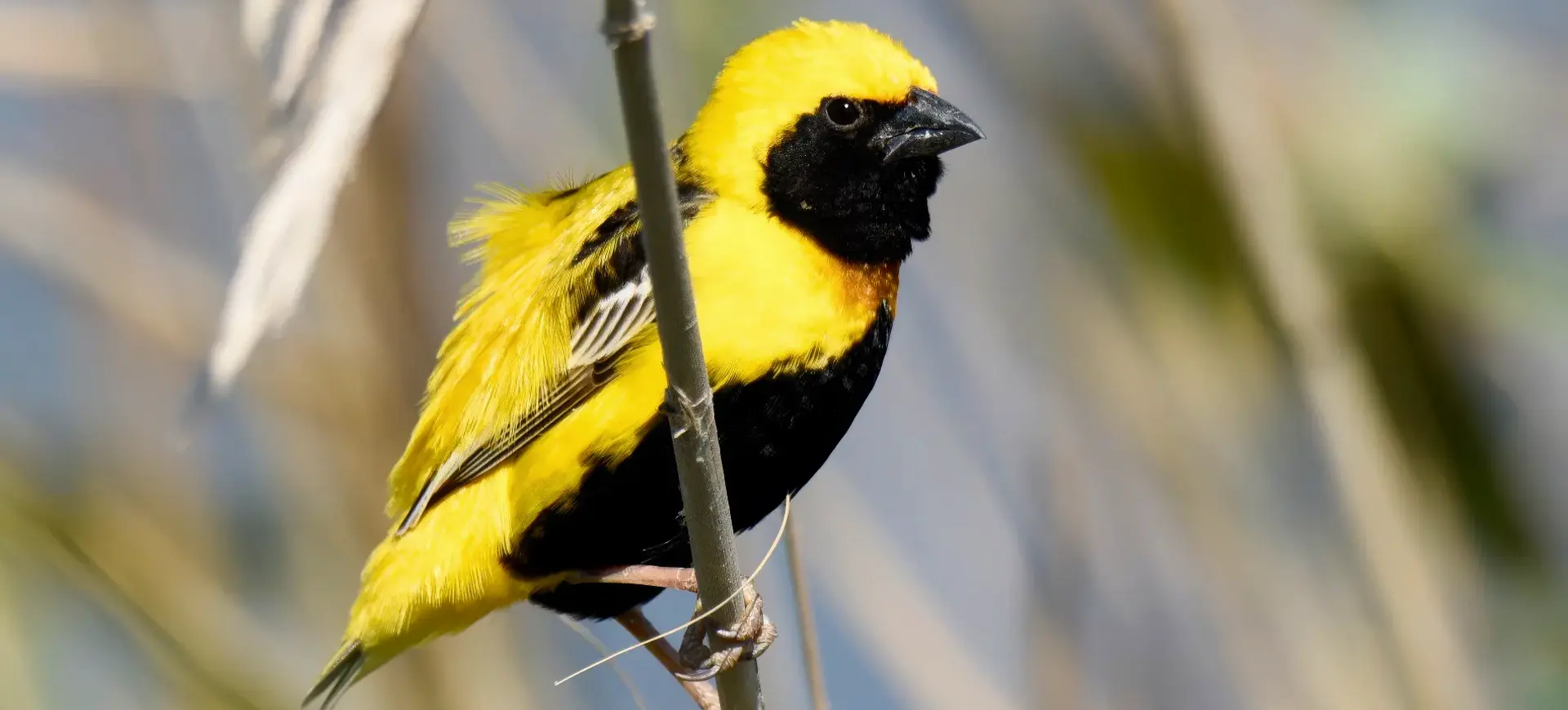Overview
The Southern Red Bishop, scientifically known as Euplectes orix, is a striking species of bird found in the southern regions of Africa. Recognized for their vivid red and black breeding plumage, males of the species undergo a dramatic transformation to attract females during the mating season, contrasting sharply with their more subdued non-breeding colors. These birds inhabit wetlands, grasslands, and agricultural areas where they can be seen foraging for seeds and insects. The Southern Red Bishop is a member of the weaver family, displaying remarkable nest-building skills that involve weaving intricate nests from grasses and reeds suspended above water or among tall vegetation.
Outside the breeding season, Southern Red Bishops form large flocks, blending into their environment with their less conspicuous brown plumage. However, when the breeding season arrives, males stake out territories and showcase their vibrant feathers, engaging in elaborate displays to woo potential mates. Their diet mainly consists of seeds, supplemented by insects, which provide them with the necessary nutrients for breeding and molting. Adaptability to various habitats, including those modified by human activities, has allowed the Southern Red Bishop to maintain stable population levels in its native range.
Their role in the ecosystem is multifaceted; as seed dispersers, they aid in the regeneration of plant life, and as insect consumers, they help control pest populations. The change in plumage color between seasons makes the Southern Red Bishop a fascinating subject of study for ornithologists and a popular sight among bird watchers. Despite their resilience, preserving their natural habitats is essential for ensuring the continued prosperity of their populations across the southern African landscape.
Taxonomy
Kingdom
Phylum
Class
Order
Family
Genus
Species
Type
Current distribution:
Southern Red Bishops are widely distributed across southern and eastern Africa, from South Africa northwards to Angola, Kenya, and the southern parts of the Democratic Republic of the Congo. Their presence is heavily dependent on the availability of suitable habitats that provide ample food and nesting opportunities. Seasonal movements and changes in habitat preference are observed, particularly in response to rainfall patterns, which influence the abundance of food and nesting materials.
The Southern Red Bishop's adaptability to various habitats has facilitated its spread across a wide range, but this also emphasizes the need for conservation efforts to protect these environments. Despite its wide distribution, monitoring is essential to understanding population trends and addressing any potential threats that could impact its numbers.
Physical Description:
In breeding season, male Southern Red Bishops are adorned with a vibrant plumage of red and black, designed to attract females. This striking contrast to their non-breeding season appearance, where they don brown, more camouflaged feathers, signifies their readiness for mating. The species has a robust body, a short, thick bill ideal for seed consumption, and a relatively short tail that contributes to its distinctive silhouette. Females and non-breeding males maintain a more subdued coloration, providing better camouflage against predators and while nesting.
The Southern Red Bishop’s physical attributes, including its strong, conical beak and sturdy legs, are adaptations that facilitate its seed-based diet and terrestrial foraging behavior. The short and rounded wings allow for quick, agile flight, crucial for navigating through dense vegetation and avoiding predators. Their well-camouflaged nests, expertly woven into the surrounding vegetation, demonstrate the bird’s intricate building skills, crucial for protecting eggs and chicks from predators and environmental elements.

Lifespan: Wild: ~5 Years || Captivity: ~10 Years

Weight: Male: 0.85-1.2 oz (24-34 g) || Female: 0.75-1.05 oz (21-30 g)

Length: Male & Female: 4.7-5.9 in (12-15 cm)

Height: Male & Female: 4.7-5.1 in (12-13 cm)

Wingspan: Male & Female: 7.4-8.3 in (19-21 cm)

Top Speed: 20 mph (32 km/h)
Characteristic:
Native Habitat:
The Southern Red Bishop is native to sub-Saharan Africa, favoring habitats that include wetlands, reed beds, grasslands, and agricultural fields where water is readily available. These habitats offer abundant food sources and the necessary materials for nest construction. The species has shown a remarkable ability to adapt to different environmental conditions, including those altered by human presence, such as irrigated fields and the outskirts of urban areas.
Conservation of these habitats is crucial for the survival of the Southern Red Bishop, as it ensures the availability of nesting sites and food resources. The bird’s preference for wetlands and grasslands underscores the importance of these ecosystems for this species and many other birds and wildlife that rely on these habitats for survival.
Biomes:
Biogeographical Realms:
Continents:
Diet:
Diet & Feeding Habits:
Southern Red Bishops’ diet predominantly consists of seeds from grasses, grains, and occasionally small insects, which provide the protein necessary during the breeding season. They forage in flocks in non-breeding seasons, utilizing their strong beaks to extract seeds from grasses and grains. During the breeding season, males, in particular, consume more insects to accumulate the extra energy needed for territorial displays and nest construction.
In captivity, their diet can be supplemented with various seeds and commercially available bird food designed for granivorous birds, mealworms, or small insects to mimic their natural diet. This dietary adaptation ensures that Southern Red Bishops receive all necessary nutrients for health, plumage maintenance, and reproductive success. The flexibility in their diet allows them to thrive in various environments, including those altered or impacted by human activities.
Mating Behavior:
Mating Description:
During the mating season, male Southern Red Bishops become highly territorial and exhibit striking red and black plumage to attract females. They engage in elaborate displays, including puffing up their feathers, performing flight dances, and singing. Males construct several nests within their territory and offer them to females as part of the courtship process. Females inspect the nests and, if satisfied, will choose a mate based on the quality of the nest and the male’s display.
The nests are woven with great skill from grasses and placed in reeds or bushes, usually over water, to deter predators. After mating, the female lays 2 to 4 eggs, which she incubates alone, while the male may guard the territory and occasionally feed the female. The chicks hatch after about 12 to 14 days and fledge approximately 2 to 3 weeks later, though they remain dependent on the parents for a short period. This polygynous mating system results in males attempting to mate with multiple females during the season, each establishing her nest within his territory.
Reproduction Season:
Birth Type:
Pregnancy Duration:
Female Name:
Male Name:
Baby Name:
Social Structure Description:
Southern Red Bishops exhibit a complex social structure that varies seasonally. Outside the breeding season, they form large, mixed-sex flocks that forage and move together, offering protection against predators and increased foraging efficiency. During the breeding season, males become territorial and polygynous, with each male establishing a territory that he defends vigorously against rivals while attracting multiple females.
This seasonal shift in social behavior reflects the species’ adaptive strategies for reproduction and survival. The communal aspect of their non-breeding flocks facilitates social learning and cohesion. At the same time, the competitive nature of the breeding season ensures that only the most fit and capable males reproduce, contributing to the genetic diversity and health of the population.
Groups:
Conservation Status:
Population Trend:
Southern Red Bishops are widespread throughout their range in southern and eastern Africa. The species has adapted well to various habitats, including those modified by human activities, which has helped maintain stable population levels. Regular monitoring and research are necessary to ensure this status remains unchanged, especially in the face of potential threats such as habitat loss and climate change.
Efforts to conserve their natural habitats are essential for Southern Red Bishop populations’ continued health and growth. The species’ ability to thrive in diverse environments highlights the importance of sustainable land use practices that consider the needs of wildlife alongside human requirements.
Population Threats:
The main threats facing Southern Red Bishops include habitat loss and degradation, particularly in drained or converted wetlands and grasslands for agricultural use. Pesticides and other chemicals used in farming can also impact their food sources, potentially leading to declines in local populations. Climate change poses an additional threat, potentially altering suitable habitats’ availability and affecting breeding season timing.
Conservation strategies aimed at mitigating these threats are crucial for the long-term survival of the Southern Red Bishop. This includes protecting and restoring natural habitats, regulating pesticide use, and addressing the broader impacts of climate change on ecosystems.
Conservation Efforts:
Conservation efforts for the Southern Red Bishop focus on habitat protection and restoration, especially in wetlands and grasslands that are critical for their breeding and foraging. Environmental regulations that limit pesticide use and encourage sustainable agricultural practices can also benefit this species. Education and awareness programs aimed at local communities and farmers can help foster a greater appreciation for the species and its role in the ecosystem.
Collaborative conservation initiatives involving governments, NGOs, and local communities are key to effectively managing and protecting Southern Red Bishop habitats. These efforts, combined with ongoing research and monitoring, will ensure the continued survival and prosperity of Southern Red Bishop populations across their range.
Additional Resources:
Fun Facts
- Southern Red Bishops are known for their striking color transformation during breeding.
- They are skilled weavers, creating intricate nests that are marvels of natural engineering.
- The species’ diet shifts to include more insects during breeding, providing necessary nutrients for mating and nesting.
- Southern Red Bishops can form flocks of hundreds or even thousands of individuals outside of the breeding season.
- Despite their vibrant breeding colors, their non-breeding plumage offers excellent camouflage in their natural habitats.
- They have been observed to adapt quickly to environmental changes, including human habitat alterations.
- Their elaborate mating dances and displays make them a favorite among bird watchers.
- The species plays a crucial role in controlling insect populations and dispersing seeds.
- Conservation efforts for the Southern Red Bishop emphasize habitat protection and sustainable land use practices.
- Despite facing threats of habitat loss and degradation, the Southern Red Bishop remains a common and widespread species, reflecting its resilience and adaptability.


